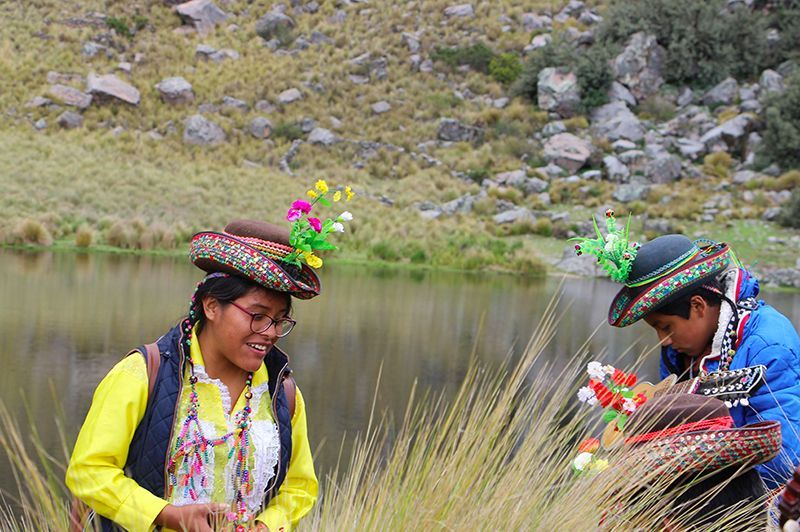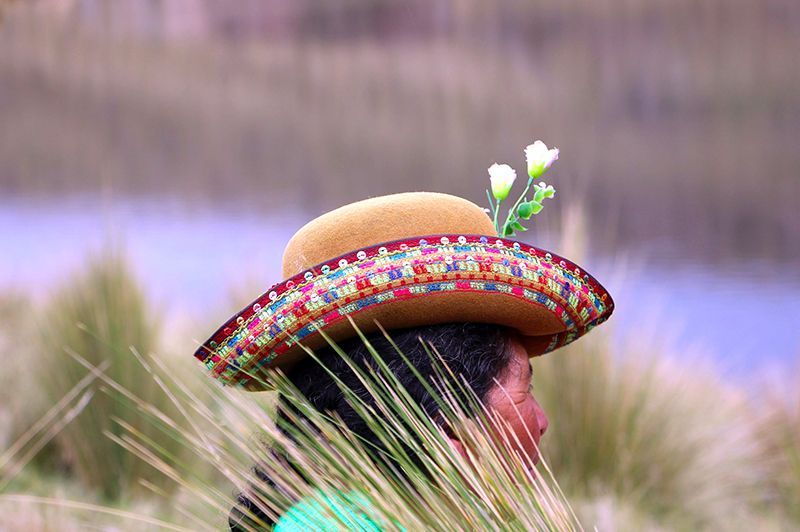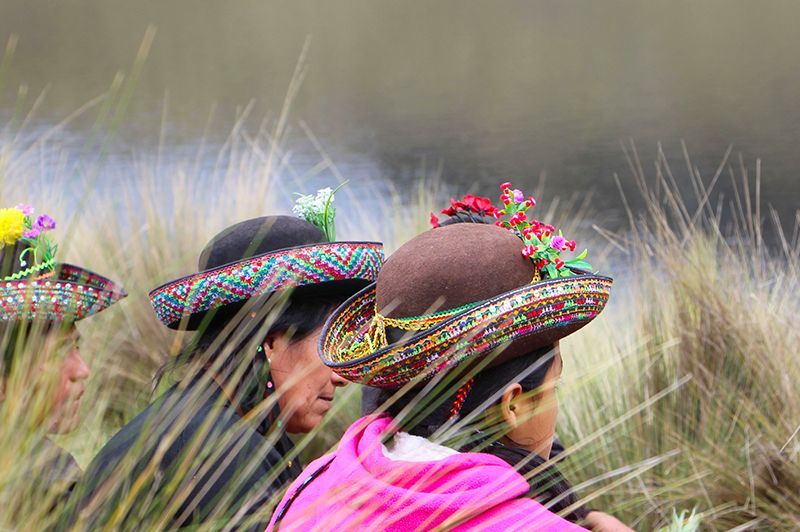Through ancient knowledge of water harvesting, women in Ayacucho (Peru) have managed to preserve this mineral.
The melodies of Jeanette Rejas Conde seem to be powerful. She is a 23-year-old woman who lives in Quispillacta (Ayacucho). Accompanied by the sound of the quena - a musical instrument used in the Andes - Jeanette sings in the Quechua language, repeating “Yakumama, ama piñakuychu, sichum pantaykipas pampachaykullaway, Yakumama hampukuy, kutiksmay” (water don't be bitter, if I have failed you in something forgive me, water come, water come back)
“We sing to the water and talk to it,” explains Magdalena Machaca, one of the founders of the Asociación Bartolomé Aripaylla (ABA), who is leading a visit to the Qinwakucho lagoon in Ayacucho (Peru). “We are nature, we are part of her. Through music we talk about our feelings with water,” says Magdalena.
 |
 |
||
| Jeanette Rejas Conde considers preserving traditional knowledge important. A very precious legacy of the ancestors in Peru. |
Through Andean knowledge, the inhabitants pay homage to water, and treat it as a living being. |
The Qinwakucho ecosystem seems to rejoice at the melodies. Suddenly, the sun's rays become stronger and warmer, some birds arrive and perch on the shore of the lagoon – which is special for the women of the ABA - because it was built by them. Using ancient, pre-Inca “water harvesting” techniques, they have built reservoirs to capture rainwater and increase its infiltration for use in times of drought. In this way they preserve the mineral, which is essential for human survival and which must be protected against climate change.
|
|
| Quispillacta is the district in Ayacucho where the women who build reservoirs to preserve water were born and live. |
Climate change in Ayacucho
|
|
As Magdalena explains, phenomena such as El Niño are more intense and in accordance with her, the study Identification of disaster risk conditions and vulnerability to climate change in the Ayacucho region of the National Environmental Information System shows that the scarcity of rainfall, an influence of climate change, will affect economic activities in this region, as well as agricultural activities, and will also generate greater drought.
“Climate change is a reality in Ayacucho. Rainfall is lower and happens at any time. In the Andes there are major problems related to droughts, floods and huaicos,” adds Dersi Zevallos, head of the National Superintendence of Sanitation (SUNASS) in Ayacucho.
|
|
Since 1994, the women of the ABA, together with various organisations, began the process of building reservoirs. Clay is used, and spaces are sought that allow capture of the mineral. However, the most important thing is to be in harmony with nature. This technique has generated a series of benefits for the Ayacucho population. Over the years they have built 121 ponds, benefiting approximately 260,000 people, who can access the mineral, consume it, and use it for different activities such as irrigation and agriculture.
 |
|
Marcela Machaca recognises that, in Ayacucho, climate change has brought disadvantages, but it has also allowed them new opportunities in agriculture, and in the generation of new microclimates. |
Ancient Andean knowledge reaches Costa Rica
"When we arrived in Costa Rica we made a ceremony to the land. Just like in Peru, we offered foods, songs, and we taught how to build the reservoirs," explained Marcela, Magdalena's sister, who travelled to the Guanacaste region with other women. They were invited by the Water Harvesting project, implemented by the Association for Research and Integral Development (AIDER), and the National Forest Financing Fund (FONAFIFO), with financing from the European Union, through the EUROCLIMA+ Programme.
Women and men farmers from Guanacaste knew the technique used and adapted it to the Costa Rican region. To date, five ponds have been built, which have a storage capacity of 35,000 cubic meters. This transfer of ancient knowledge comes at a time of water stress for Costa Rica, where a series of efforts are being made to address climate change. According to IAgua, the Central American country faced its most severe drought in the last 75 years, and one of the causes is the increase in greenhouse gases.
Gustavo Solano, binational director of the project, has indicated that through this ancient experience the women in Ayacucho and the farmers in Guanacaste are adapting to climate change, preserving water and living in harmony with nature. “Without the women of the ABA the ponds would not have been built, thanks to them there is a place to store the mineral. Harvesting water is an inexpensive local system with a very fast positive impact”.
Solano also emphasised that the use of ancient techniques implies, according to the indigenous cosmovision, the recognition of water as a living being and therefore it is involved in a spirituality that does not exist in Costa Rica. “Through the project, the indigenous people of Quispillacta have transmitted this wisdom of respect for water, which has been internalised in Costa Rican communities,” he said.
 |
|
The Machaca sisters are engineers and pass ancient knowledge on to new generations
|
“We must never stop talking to the water, we must give it affection and a lot of understanding,” says Magdalena. This learning - even in the midst of globalisation - has permeated even the youngest. Jeanette Rejas Conde is proof of this. Through music, the conservation of ecosystems is revalued in Andean customs. Priority is given to the love of nature that is manifested in the protection of water, in the celebration of its existence, in the respect for its processes and in the understanding of the changes it faces.
The women of the ABA often say that water unites and generates bonds and it seems that they are not wrong. Andean wisdom has moved to Costa Rica, and it seems that through the spirituality and movements of this mineral, ancient knowledge could reach other corners of the world.
Data
- Through the Water Harvesting project, the women of the ABA have twice visited the communities of Canañas and Bagaces in Guanacaste. They have accompanied Costa Rican farmers throughout the process of building the reservoirs.
The same process has been put into practice in the Chira Basin (Piura) where 2 reservoirs have been built. - Through South-South cooperation, Peru is transferring knowledge about water harvesting, and Costa Rica is teaching about ecosystem services, i.e. that economic, social and environmental recognition be given for water protection, but at the same time that a water canon be put into practice and compensation be given for the profits obtained from the use of the resource. These practices will benefit communities and countries.
- The project allows Peru and Costa Rica to adapt to climate change, and thus carry out actions that add to the scope of their Nationally Determined Contributions (NDC).






